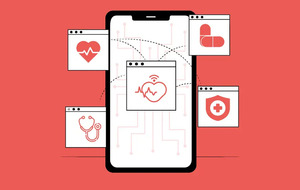Why is it the right time for your healthcare business to go digital with payments?
Body
Payments make the entire treatment process more complex and elongated. If digitizing them can make the process simpler, it would add up to benefit the healthcare business. With immediate effect, you will be able to see how efficient it makes the system. Let us discuss some benefits associated with digital payments in healthcare.
It is a win-win situation for both the business and the patients. Patients are more likely to seek medical attention and receive the best care, while providers are better able to offer treatments and reliably collect payments.
As noted, patients have been increasingly preferring digital healthcare payments rather than manual ones as it eases the process at every step.
Here are more ways how digitalizing your healthcare business can transform your patient experience:
Improves communication and engagement
Patients desire quick, easy access to all their information in the digital age, including test results and unpaid balances. In order for patients to check in, schedule an appointment, and pay for their visit on their laptop or smartphone, digital payments are simple to integrate with other healthcare digital solutions.
In light of the US Centers for Medicare and Medicaid Services Hospital Price Transparency Rule, implementing a digital payment system requires improving patient communication and information access. The law mandates that hospitals in the United States provide transparent and easy-to-access pricing information for procedures and devices online.
In a survey, 44% of patients confirmed paying their medical bills more quickly when they receive digital or phone billing reminders. Providers can speed up payment collection and boost both clinical and financial outcomes with the help of active online portals and healthcare digital payment models.
Improves patient satisfaction
Digital convenience has now become the norm. It is not something out of the ordinary anymore. The usage of contactless payments was broadened by COVID-19 with concerns of convenience. But as we have seen and experts have mentioned, these preferences and practices have become a habit.
Adding digital payment options to medical practices encourages more devoted and satisfied patients. In fact, according to data, a third of patients are dissatisfied with the way their healthcare provider handles manual billing. Independent healthcare practices cannot afford to lose clients because of slow billing and payment procedures in an era of escalating competition.
Therefore, digitizing operations might be a great solution if you are setting up a healthcare business or struggling to hold back your customers as an established practice.
Provides a seamless, modern check-out experience
Imagine having a patient at your office who receives a text message while waiting for their doctor in the exam room. The message would contain an invoice for their co-pay that can be paid at the time of their appointment or shortly after. These customers won’t waste time at the register paying for something they could easily send from their phone in the waiting area or at home. Patients can continue with their day immediately after seeing their provider with a modern check-out procedure.
Additionally, you will receive more patient satisfaction points if you switch every process to a contactless alternative in a post-pandemic environment. Front desk staff will have more time to focus on improving the patient experience by immediately answering any questions or notes they left rather than transacting payments on registers.
Creates a transparent ecosystem
A typical medical bill includes a lot of information that might be hard for a layman to grasp. This can confuse the patient or his or her family. But through healthcare digital payment systems, every dollar spent is monitored and verified. Misappropriation of money is next to impossible.
A great deal of trust and confidence builds because the patient agrees with the bill’s totality and receives all the information transparently. If there are any errors or misunderstandings, changes can be made right away and will be reflected in real time. This, in turn, increases customer satisfaction and builds trust.
Technologies you can use
While there are plenty of technologies in the market, you can use the one most suitable for your healthcare business when you decide to integrate digital payments into your services:
Biometric authentication
Biometric authentication is a type of verification that uses a person’s biological and physical traits to analyze them with different technologies like heartbeat analysis, vein mapping, facial recognition, iris identification, and fingerprint scanners.
Mobile apps and other digital payment agents can employ biometric verification to confirm a transaction in the healthcare sector. Smartphones, for instance, can send data along with a payment request that includes behavioral biometric data. By detecting discrepancies in biometric data and payment behavior, these extra signals will increase authentication’s robustness and improve fraud detection.
we can help you by conceptualizing, designing, developing, and deploying solutions to provide you with the best healthcare software development services. With extensive market research and innovative designs, Appinventiv can come up with an impactful solution that will cater not only to your needs but your patients’ needs as well. So, you will be able to trust them to provide you with a safe, secure, and fraud-proof healthcare digital payment system.
With all possibilities, it is now time to make a shift to digital healthcare payments to improve your business and patient satisfaction. Reach out to a service provider like Appinventiv to create a wonderful, easy, and reliable solution for digital payments in healthcare.
Open bank APIs
Through a third-party application, legacy banks can exchange data and information thanks to application programming interfaces (APIs). Any business (B2B, B2B2C, or BaaS) can incorporate its products onto a platform of a nonfinancial company by using APIs.
Codes
Europay, Mastercard, and Visa (EMV) technology has progressively gained traction and provided clients with a more automated and safe method of payment.
The EMV system is well known for utilizing unique transaction-specific codes. The security of bank accounts is greatly improved by the use of these temporary codes. It also influences how we manage banking systems. These codes are soon replacing plastic cards as a more practical and safe way to transact money.












Comments